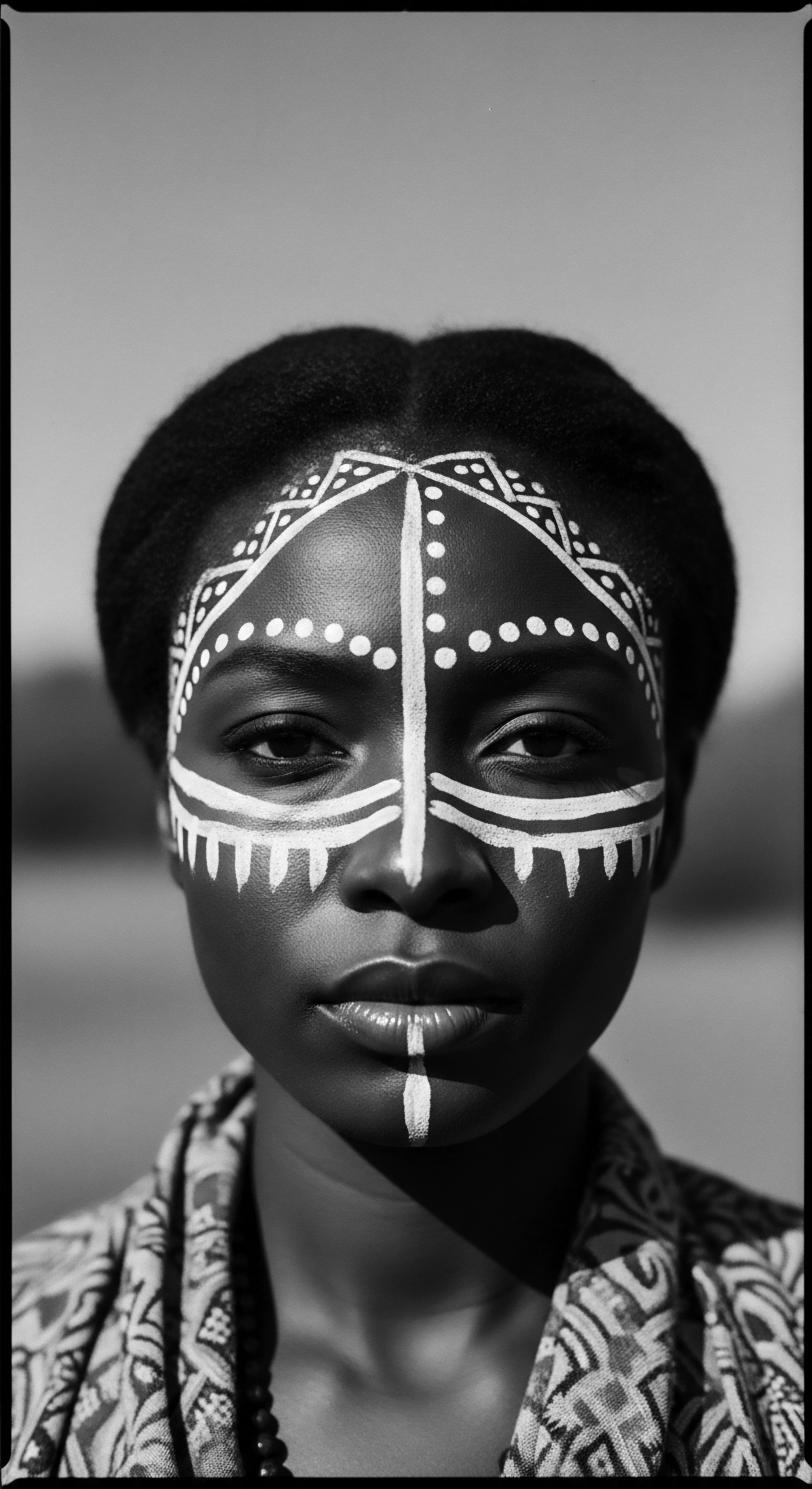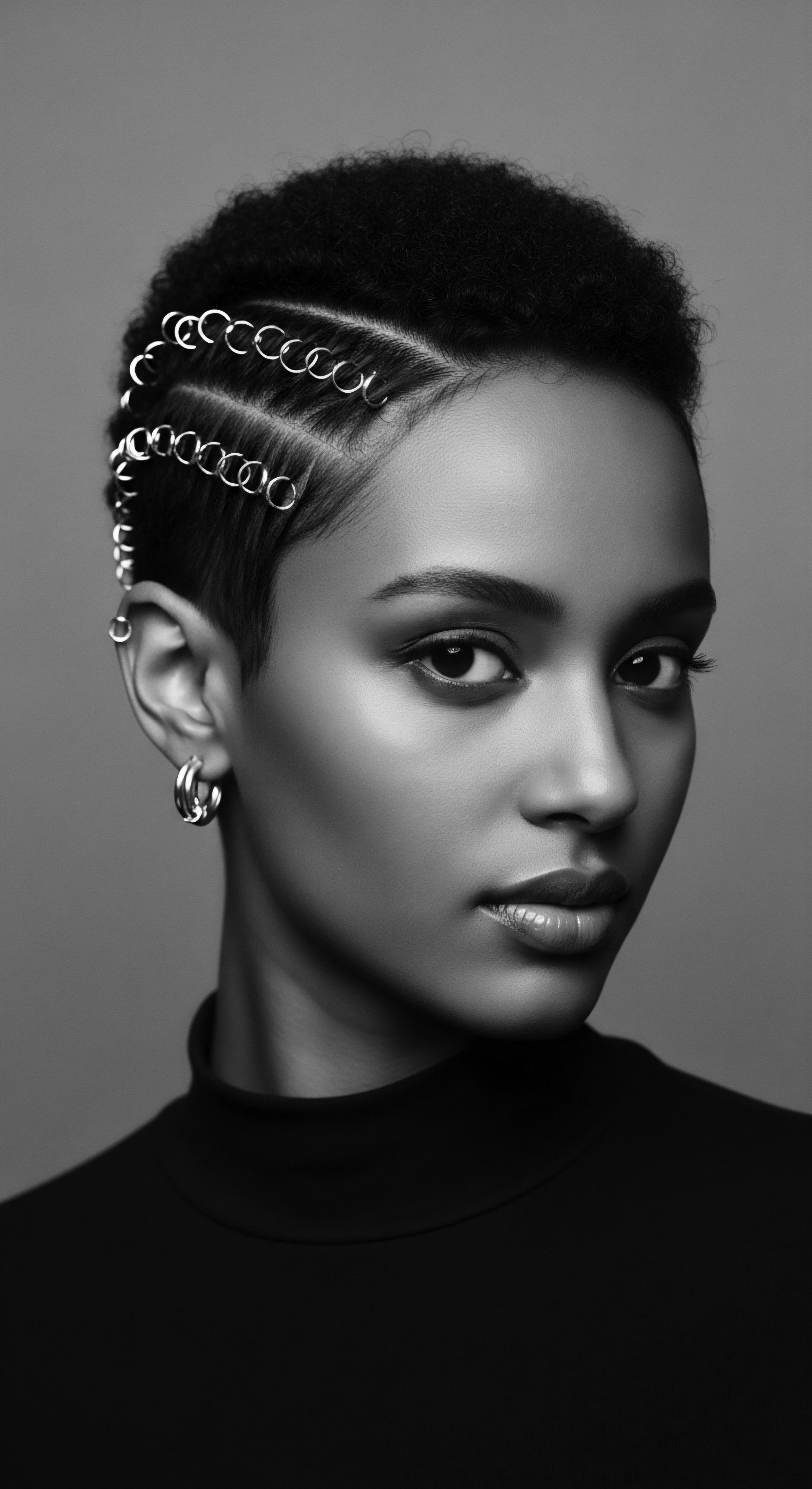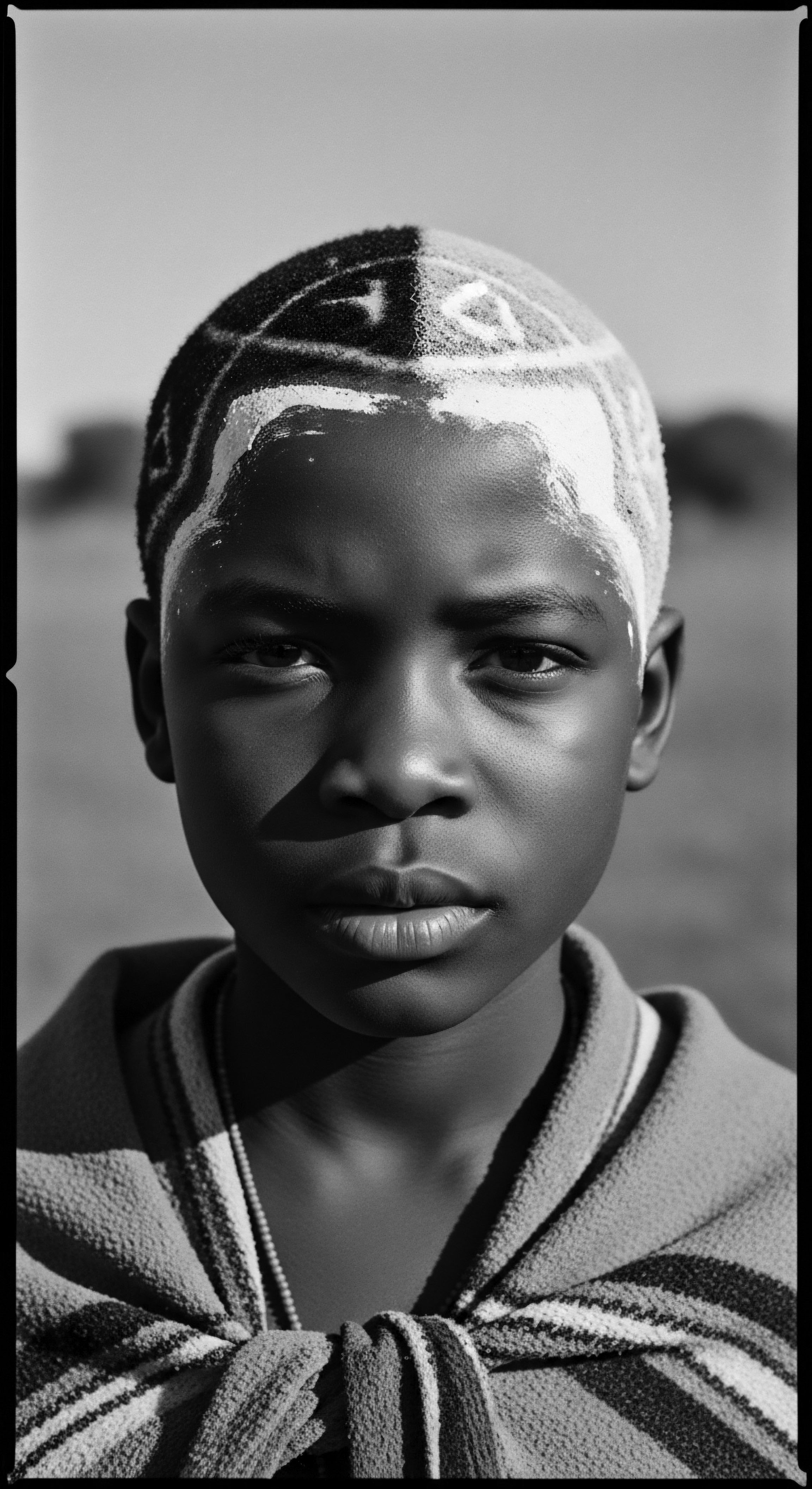
Fundamentals
The concept of Racial Identity, within Roothea’s living library, extends far beyond a mere categorization of human groups based on physical appearance. It represents a profound delineation of how individuals and communities perceive themselves and are perceived by the wider world, rooted deeply in shared ancestral legacies, cultural practices, and collective experiences. This inherent sense of belonging, often shaped by outward markers such as the glorious coils, kinks, and waves of textured hair, speaks to an inherited memory, a continuous stream of tradition flowing from the source of our being.
From the earliest whispers of humanity, communal bonds were often articulated through shared customs, language, and distinct physical presentations. Hair, with its diverse textures and forms, served as a primary visual language, communicating status, lineage, and affiliation. The fundamental significance of hair texture, particularly within Black and mixed-race ancestries, lies not just in its biological uniqueness but in its capacity to carry generations of meaning. It is a testament to the earth’s varied artistry, mirrored in the diverse crowns that grace our heads.
In pre-colonial African societies, the styling of hair was an elaborate social ritual, a daily act of cultural affirmation. These practices were not simply about aesthetics; they were integral to the very fabric of communal life, reflecting a person’s journey through life. A young woman’s braided patterns might declare her marital availability, while a warrior’s sculpted coiffure could signify his readiness for battle.
The communal aspect of hair care, where hands would gently tend to another’s strands, created intimate spaces for storytelling, for the passing down of ancestral wisdom, and for the strengthening of familial ties. This deep connection between hair and communal existence formed a foundational layer of what we now recognize as racial identity, long before external forces sought to redefine it.
Racial Identity, at its core, is a vibrant recognition of shared heritage, often expressed through the living artistry of textured hair.
Understanding this elemental connection requires us to look beyond modern constructs and to hear the echoes from ancient practices. The care for hair, for instance, involved an intimate knowledge of local botanicals—shea butter, various oils, and plant extracts—each selected for its ability to nourish and protect the hair’s inherent structure. These ancestral methods, passed down through oral tradition and embodied practice, represent a holistic approach to wellbeing, where the health of the hair was intrinsically linked to the health of the spirit and the strength of the community.
The early conceptualization of racial identity was thus organic, arising from shared ways of living, being, and presenting oneself within a defined collective. The particular characteristics of hair texture were not viewed as markers of inferiority or superiority, but simply as natural variations, each possessing its own beauty and requiring specific, thoughtful care. This original perception stands as a powerful reminder of the inherent dignity and beauty that resides within every strand, untouched by later, imposed judgments.

The Ancestral Language of Strands
Long before the imposition of rigid classifications, African communities across vast landscapes employed hair as a rich, living language. The specific designs, the intricate patterns, and the adornments chosen for one’s coiffure served as visual declarations. These declarations spoke of an individual’s place within their collective, detailing their age, their marital status, their spiritual leanings, or even their social standing.
A particular braid style might signify a woman’s passage into motherhood, while a specific adornment could mark a chief’s wisdom. This deep semiotic function of hair meant that observing someone’s head could tell a comprehensive story of their life and their belonging.
Consider the meticulous artistry of West African braiding traditions, some dating back millennia. These were not casual styles; they were deliberate expressions of cultural belonging. The preparation of the hair itself was often a ritual, involving natural cleansers and emollients derived from the land, preparing the scalp and strands for the hours of communal styling. This communal aspect, where individuals gathered to tend to each other’s hair, fostered deep intergenerational bonds, solidifying the shared understanding of their collective identity.
- Cornrows ❉ Often indicating tribal affiliation or marital status in various West African cultures.
- Locs ❉ Historically worn by spiritual leaders or warriors in some African societies, symbolizing strength and connection to higher realms.
- Braids ❉ Employed for communication, social standing, or even as maps for escape routes during times of adversity.
This historical practice of using hair as a cultural compass highlights a foundational aspect of racial identity ❉ its rootedness in a collective, self-defined heritage. The original meaning of textured hair was one of pride and communal cohesion, an outward manifestation of an inner, shared spirit. The interpretation of these hair practices was universally understood within their respective communities, a silent yet potent form of communication that transcended spoken words. This deep-seated understanding forms the very bedrock of Roothea’s philosophy, recognizing that the journey of textured hair is inextricably linked to the journey of identity itself.

Intermediate
Moving beyond the foundational understanding, the intermediate comprehension of Racial Identity recognizes its dynamic and often contested nature, particularly as it intersects with the profound history of textured hair. This perspective acknowledges that while identity begins as an intrinsic, communal recognition, it also undergoes significant shaping by external forces, notably through periods of profound historical upheaval and societal imposition. The narrative of Black and mixed-race hair, in particular, stands as a poignant testament to this evolution, transforming from a marker of intrinsic worth to a battleground for dignity and self-definition.
The transatlantic slave trade, a period of immense human suffering, severed countless individuals from their ancestral lands and traditional practices. One of the first acts of dehumanization inflicted upon enslaved Africans was the forced shaving of their heads. This act aimed to strip away their cultural heritage, their personal dignity, and their collective identity, severing the visible connection to their origins where hair held such deep meaning. Yet, even in the face of such brutality, the spirit of resilience persisted.
Enslaved individuals ingeniously adapted their hair practices, using cornrows to map escape routes or concealing rice grains within intricate styles to sustain themselves and their kin during arduous journeys. This transformation of hair from a cultural marker to a tool of survival and resistance underscores the enduring power of ancestral practices, even under duress.
The historical trajectory of textured hair reveals a continuous dance between imposed perceptions and unwavering self-definition.
As generations passed and the descendants of enslaved Africans found themselves in new lands, the societal pressures to conform to Eurocentric beauty standards intensified. The concept of “good hair” versus “bad hair” emerged, a false dichotomy designed to devalue natural, tightly coiled textures and privilege straighter forms. This manufactured hierarchy deeply affected the self-perception of Black and mixed-race individuals, leading many to seek methods to alter their hair’s inherent structure through chemical relaxers and hot combs.
These tools, while offering a semblance of acceptance in a hostile world, often came at a cost to hair health and an individual’s psychological well-being. The very definition of beauty became entangled with racialized notions, making hair a visible symbol of societal acceptance or rejection.
The mid-20th century witnessed a powerful reclamation of racial identity through the emergence of the Civil Rights and Black Power Movements. This period marked a profound shift in consciousness, as individuals began to assert their inherent worth and beauty, rejecting imposed standards. The Afro, a magnificent crown of natural coils, became a potent emblem of Black pride, unity, and defiance.
It was a visual declaration of self-acceptance, a statement that Black was indeed beautiful in all its forms. This reassertion of textured hair as a symbol of collective identity played a significant part in reshaping societal dialogues about race and beauty, reminding us that true meaning stems from within, not from external validation.

Echoes of Resistance ❉ Hair as a Voice
The journey of textured hair through history is a testament to unwavering human spirit. During the era of enslavement, when overt expressions of African heritage were suppressed, hair became a clandestine canvas for cultural continuity. Enslaved women, with ingenuity and profound connection to their roots, devised intricate braiding patterns.
These were not merely decorative; they served as a discreet means of communication, sometimes encoding pathways to freedom or even carrying seeds for planting in new, uncertain lands. This silent language, passed from one generation to the next, preserved a vital aspect of their collective identity, a defiance against the erasure of their past.
The 1960s and 1970s saw a resurgence of this powerful connection between hair and racial identity with the rise of the Civil Rights and Black Power movements. The decision to wear one’s hair in its natural, unadulterated state—the glorious Afro—became a potent political statement. It represented a conscious rejection of Eurocentric beauty ideals that had long dictated what was considered acceptable or desirable. This collective embrace of natural texture symbolized self-acceptance, solidarity, and a reclaiming of ancestral pride.
Figures like Angela Davis, with her iconic Afro, transformed hair into a visible sign of resistance and a declaration of racial consciousness. (Byrd & Tharps, 2014)
The social and psychological weight carried by textured hair during these periods is immense. For many, the act of straightening one’s hair was a necessity for survival, a way to navigate a world that deemed their natural coils “unprofessional” or “unruly.” Yet, the internal conflict between conforming for societal acceptance and desiring to express an authentic self was a constant presence. The journey to embrace natural hair was, and continues to be, a deeply personal yet universally resonant experience for many Black and mixed-race individuals. It is a path towards healing, towards shedding imposed narratives, and towards celebrating the innate beauty of one’s heritage.
The legacy of this historical struggle continues to shape contemporary conversations about hair and identity. Today’s natural hair movement, while building on the foundations laid by earlier generations, extends the dialogue to include greater appreciation for the vast spectrum of textured hair, from loose waves to tightly coiled patterns. It seeks to dismantle the remaining vestiges of hair discrimination in schools and workplaces, asserting the right to self-expression and cultural authenticity. This ongoing movement underscores that racial identity, particularly as it relates to hair, is not a static concept but a living, evolving declaration of who we are and from whom we descend.
| Historical Period Pre-Colonial Africa |
| Hair's Role in Identity Cultural marker of tribe, status, age, spiritual beliefs, marital standing. |
| Associated Practices & Meanings Intricate braiding, adornments with shells and beads, communal grooming rituals, use of natural emollients. |
| Historical Period Transatlantic Slave Trade & Colonialism |
| Hair's Role in Identity Site of dehumanization (forced shaving) and covert resistance (hair as map/storage). |
| Associated Practices & Meanings Head coverings, concealed cornrows, introduction of hair straightening methods to conform. |
| Historical Period Civil Rights & Black Power Movements (Mid-20th Century) |
| Hair's Role in Identity Symbol of pride, defiance, and collective racial consciousness. |
| Associated Practices & Meanings The Afro as a political statement, rejection of Eurocentric beauty standards. |
| Historical Period Contemporary Era (Natural Hair Movement) |
| Hair's Role in Identity Personal expression, holistic wellness, continued advocacy against discrimination. |
| Associated Practices & Meanings Diverse natural styles (locs, twists, braids), focus on hair health, CROWN Act legislation. |
| Historical Period This table illustrates how hair, a biological attribute, has been continuously shaped by historical forces and cultural agency, serving as a powerful conduit for racial identity across centuries. |

Academic
Racial Identity, viewed through an academic lens and particularly within Roothea’s commitment to Textured Hair Heritage, represents a complex and deeply significant sociopolitical construct, distinct from biological race yet inextricably linked to its lived experience. It is not merely a classification based on observable phenotypic characteristics, such as hair texture or skin tone, but rather a dynamic, fluid sense of self and collective belonging that arises from the historical, cultural, psychological, and economic factors associated with membership in a particular racial group. The strength and meaning of this identity are continuously processed and internalized by individuals, often in response to societal perceptions and systemic structures. Hair, in this discourse, emerges not as a superficial adornment, but as a profoundly charged site where racial identity is both performed and policed, a physical manifestation of a rich, often contested, ancestral legacy.
The academic investigation into racial identity recognizes that while human genetic variation is continuous and does not neatly align with discrete racial categories, the social construction of race has created tangible realities of power, privilege, and oppression. Hair texture, in particular, has served as a primary visual cue in the racialization process, a process by which individuals are attributed racial meaning and categorized within societal hierarchies (Smedley & Smedley, 2005). This historical assigning of meaning has profound implications for self-perception and mental well-being within Black and mixed-race communities. The physical attributes of textured hair, often described with derogatory terms for centuries, became intertwined with narratives of inferiority, impacting everything from personal esteem to professional opportunities.
The very concept of “good hair” versus “bad hair” is a powerful testament to the internalization of Eurocentric beauty standards within racialized societies. This fabricated binary, rooted in the legacy of slavery and colonialism, posits straighter, looser curl patterns as desirable and tightly coiled, natural textures as unruly or unprofessional. The psychological burden of this imposed aesthetic hierarchy is considerable. Research indicates that the constant exposure to messages devaluing natural hair can lead to internalized racism and significant psychological distress (Sosoo et al.
2019). For instance, a study examining hair change attitudes found that beliefs such as “straight hair is better than my natural hair texture” intensified the association between racial discrimination and subsequent anxiety symptom distress among African American women (Sosoo et al. 2019). This highlights the insidious way external societal judgments can permeate individual self-concept, particularly when a visible trait like hair is constantly scrutinized.
Racial Identity is a lived experience, deeply shaped by how textured hair is perceived, both within and outside ancestral communities.
Moreover, the economic dimensions of this racialized beauty standard cannot be overlooked. The pressure to conform has historically fueled a multi-billion dollar hair care industry, often promoting products designed to alter natural hair texture through chemical straightening or heat. This economic cycle perpetuates a dependency on external modifications, diverting resources and attention away from the holistic care and celebration of natural hair.
The ongoing legal battles and legislative efforts, such as the CROWN Act in the United States, which seeks to prohibit discrimination based on hair texture and protective hairstyles, underscore the persistent societal challenges faced by individuals with textured hair in academic and professional settings. These legal interventions validate the reality that hair discrimination is a form of racial discrimination, impacting access to education and employment.

The Unbound Helix ❉ Hair as a Vector of Identity Reclamation
The academic exploration of racial identity, particularly through the lens of textured hair, delves into the profound ways in which communities reclaim and redefine their collective selfhood. This process of reclamation is not merely a reaction to oppression; it is an active, conscious assertion of ancestral dignity and cultural continuity. The natural hair movement, a contemporary manifestation of this assertion, represents a significant shift in aesthetic paradigms and psychological well-being for many Black and mixed-race individuals. It is a collective declaration that authentic beauty resides within the diverse spectrum of natural textures, unburdened by imposed Eurocentric ideals.
A powerful statistic illustrating the persistent societal pressure and the subsequent act of reclamation comes from a 2019 Dove study, which reported that Black Women are 3.4 Times More Likely to Be Perceived as Unprofessional Due to Their Hair Presentation. This same study revealed that Black Women are 1.5 Times More Likely to Be Sent Home or Face Disciplinary Action Due to “unprofessional Hair,” leading 80% of Black Women to Alter Their Natural Hair Texture to conform to organizational norms (Dove, 2019, cited in Johnson et al. 2023).
This data paints a stark picture of the real-world consequences of hair discrimination, yet simultaneously underscores the immense courage and agency involved in choosing to wear one’s hair naturally, despite these systemic barriers. The decision to embrace natural texture, therefore, becomes a conscious act of resistance, a personal revolution that resonates with generations of ancestral defiance.
The socio-psychological impact of hair discrimination extends beyond individual experiences, affecting collective identity formation and community cohesion. When individuals within a racial group face consistent devaluation of a shared physical trait, it can lead to internalized negative stereotypes. However, a strong sense of racial identity can serve as a protective factor against the detrimental effects of race-related stress and discrimination (Sellers et al. 1997).
The communal practices surrounding natural hair care, from shared styling techniques to online communities, provide spaces for affirmation, education, and mutual support, strengthening this collective identity. These spaces become living archives of ancestral wisdom, where traditional methods of care are rediscovered and adapted for contemporary life, fostering a sense of belonging and shared purpose.
The anthropological perspective reveals that hair has always been a communicative tool, a visual language conveying intricate social meanings. In pre-colonial African societies, specific hairstyles conveyed information about age, marital status, social rank, and even spiritual beliefs (Byrd & Tharps, 2014). The erasure of these meanings during the transatlantic slave trade was a deliberate act to dismantle identity.
The re-emergence of natural hair styles today, such as cornrows, locs, and Afros, is thus a profound act of cultural memory and a reconnection to these ancient forms of communication. It is a statement that the narratives of the past are not forgotten, but are living, breathing realities shaping the present and informing the future.
From a scientific standpoint, understanding the unique structural properties of textured hair – its curl pattern, density, and cuticle arrangement – validates the necessity for specialized care practices that often echo ancestral wisdom. Modern trichology, when viewed through a heritage lens, can affirm the efficacy of traditional methods like oiling, protective styling, and gentle manipulation. For example, the practice of applying natural oils and butters, deeply rooted in African ethnobotany, helps to seal moisture into the hair shaft, compensating for the natural tendency of coiled hair to be drier due due to its structural characteristics (Sherrow, 2023). This scientific validation strengthens the cultural argument for preserving and valuing these inherited practices, transforming them from mere tradition into evidence-based care.
The ongoing academic discourse surrounding racial identity and hair calls for an interdisciplinary approach, drawing from sociology, psychology, anthropology, and critical race theory. It challenges us to look beyond simplistic definitions and to appreciate the profound meaning of hair as a site of historical struggle, cultural resilience, and ongoing self-determination. The journey of textured hair is a powerful testament to the enduring human capacity to find beauty, meaning, and identity even in the face of systemic adversity, continuously weaving new narratives from the enduring threads of the past.
- Internalized Racism ❉ The psychological adoption of negative societal stereotypes about one’s own racial group, often manifested through negative self-perception of physical traits like hair.
- Hair Discrimination ❉ The practice of treating individuals unfairly based on their hair texture or protective hairstyles, a form of racial discrimination with significant societal and psychological consequences.
- Afrocentricity ❉ A framework that centers African people and descendants, reasserting agency and viewing the world from a Black perspective, profoundly influencing the natural hair movement.

Reflection on the Heritage of Racial Identity
As we conclude this exploration of Racial Identity within Roothea’s living library, we are left with a deep sense of the enduring spirit that resides within each coil, kink, and wave. The journey of textured hair is not merely a biological phenomenon; it is a profound testament to the resilience of human heritage, a continuous narrative etched in every strand. From the communal hearths of ancient Africa, where hair was meticulously sculpted to declare lineage and purpose, to the clandestine acts of defiance during enslavement, where braids became maps to freedom, the story of hair is the story of identity itself.
The echoes of ancestral wisdom reverberate in our present-day rituals of care. The gentle application of nourishing oils, the patient detangling, the deliberate styling of protective forms – these are not simply routines, but acts of remembrance, connecting us to generations who understood the sacred bond between self and strand. The natural hair movement, in its vibrant diversity, stands as a living archive, a testament to the power of collective consciousness in reclaiming narratives that were once suppressed. It is a celebration of authentic beauty, a recognition that our unique textures are not flaws to be corrected, but crowns to be honored.
The path ahead calls for a continued reverence for this heritage. It calls for us to challenge remaining biases, to advocate for spaces where all hair textures are celebrated without judgment, and to pass on the knowledge of holistic care rooted in ancestral practices. The soul of a strand carries the weight of history, the joy of reclamation, and the promise of a future where racial identity, expressed through the glorious diversity of textured hair, is unequivocally affirmed as a source of strength, beauty, and undeniable belonging. May we always remember the deep roots that nourish our crowns, allowing us to stand tall, unbound, and truly ourselves.

References
- Byrd, A. D. & Tharps, L. L. (2014). Hair Story ❉ Untangling the Roots of Black Hair in America. St. Martin’s Griffin.
- Banks, I. (2000). Hair Matters ❉ Beauty, Power, and Black Women’s Consciousness. New York University Press.
- Jacobs-Huey, L. (2006). From the Kitchen to the Parlor ❉ Language and Becoming in African American Women’s Hair Care. Oxford University Press.
- Rooks, N. M. (1996). Hair Raising ❉ Beauty, Power, and the Transformation of Black Women’s Identity. Rutgers University Press.
- Helms, J. E. (1995). An update of Helms’s (1984) racial identity model. In J. G. Ponterotto, J. M. Casas, L. A. Suzuki, & C. M. Alexander (Eds.), Handbook of multicultural counseling (pp. 181–198). Sage Publications.
- Sellers, R. M. Rowley, S. A. J. Chavous, T. M. Shelton, J. N. & Smith, M. A. (1997). Multidimensional model of racial identity ❉ A reconceptualization of African American racial identity. Personality and Social Psychology Review, 2(1), 18-39.
- Sosoo, E. E. Dottin, S. & Taylor, R. J. (2019). Hair change attitudes exacerbate the association between racial discrimination and subsequent anxiety symptom distress. Journal of Black Psychology, 45(8), 643-662.
- Cobb, J. N. (2023). New Growth ❉ The Art and Texture of Black Hair. Duke University Press.
- Sherrow, V. (2023). Encyclopedia of Hair ❉ A Cultural History (2nd ed.). Greenwood.
- Johnson, C. M. E. (2024). Natural Black Beauty and the Politics of Hair. New York University Press.
- Smedley, A. & Smedley, B. D. (2005). Race in North America ❉ Origin and Evolution of a Worldview (3rd ed.). Westview Press.
